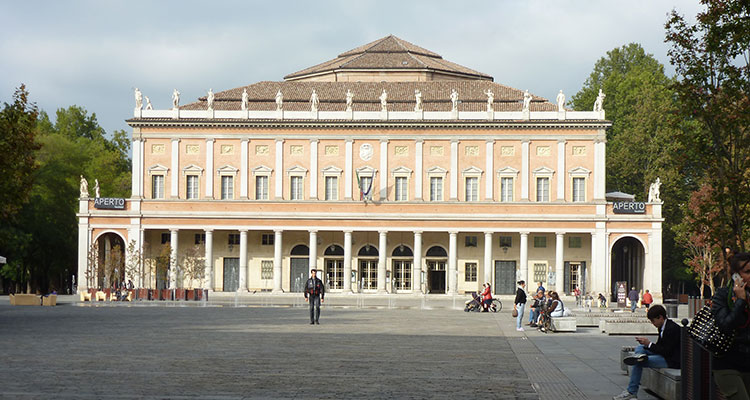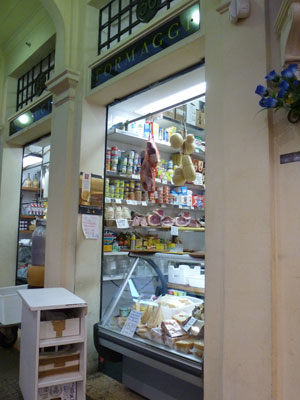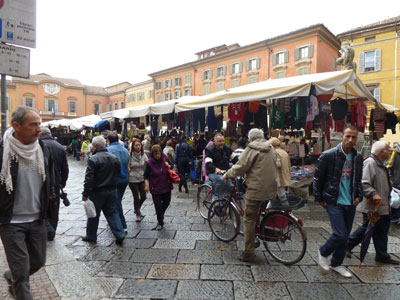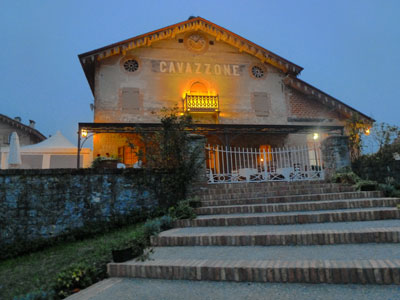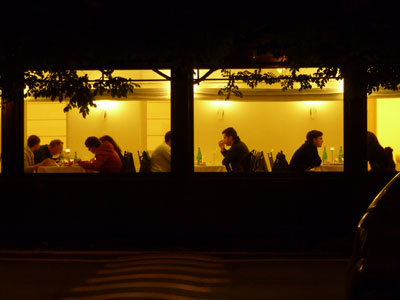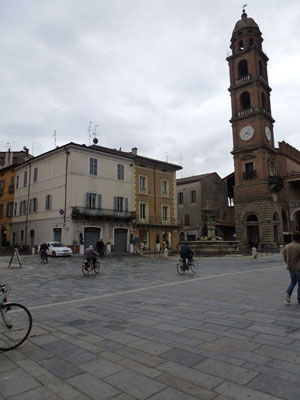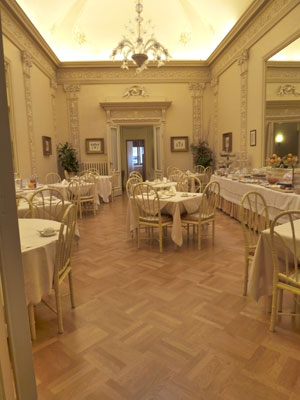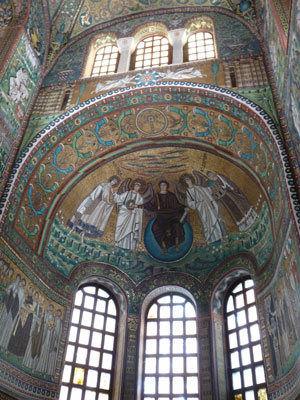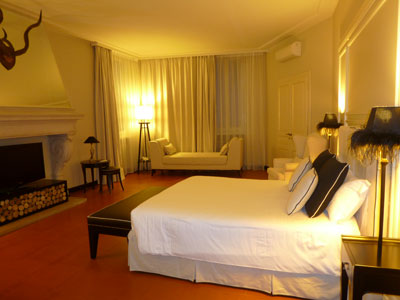Enjoying the cuisine of Italy’s Emilia-Romagna
This article appears on page 6 of the February 2013 issue.
by Beth Habian, Features Editor
The dramatic peaks of the Dolomites, the golden hills of Tuscany, the monumental architecture of Rome and the exquisite art collections of Florence — Italy has, for centuries, attracted travelers whose interests are as varied as the countries from which they come. But for those looking for a journey of gastronomic pleasure, there is one region of Italy that should not be missed.
Stretching from the Adriatic Sea to the Po River and bordered north and south by mountains, the plains of Emilia-Romagna are made of some of Italy’s richest soil.
Add to that the region’s varied climate and you get, in one compact location, an area able to produce the entire range of products for which the country is famous.
Its wheat fields provide the beginnings of the finest pasta; cornfields make polenta possible; grasses feed the cattle that produce rich milk used for the prized Parmigiano Reggiano; vineyards offer a bounty of grapes used for Lambrusco wine and balsamic vinegar, and pigs give their lives for the creation of delectable cured meats and sausages. Fish is also in abundance — freshwater from the Po and saltwater from the sea — as is a variety of fruits and vegetables.
Reggio Emilia
I had visited Emilia-Romagna in 1999 with Marie Rizziello of Treasures of Italy as part of a food-focused tour. I was introduced to some of the region’s products — tasting a 40-year-old aceto balsamico at Modena’s annual balsamic vinegar festival and seeing how Parmigiano Reggiano cheese is produced — but there was so much more to experience. So when Marie invited me to join her in October 2012 for a more in-depth look at the area, I couldn’t say ‘Yes!’ fast enough.
Our trip began in Reggio Emilia. Many travelers might be more familiar with the neighboring towns of Parma, Bologna and Modena, but it is for precisely that reason that Reggio makes a perfect base for visitors looking for a pleasant place to stay that is not overrun by tourists.
The first stop for Marie and me was Cavazzone (phone +39 0522 858100), a farmhouse-turned-inn located in the hills about 15 minutes from downtown Reggio. On my first trip to the area, I had visited Cavazzone to tour its balsamic vinegar cellar. At that time, it did not offer accommodations, so I was thrilled to see its transformation into a lovely, family-run agriturismo.
Now comfortably furnished in rustic style, its six rooms (€69-€160, or $91-$211, per night, including breakfast) can accommodate up to 18 guests, total. Unfortunately, as we were there in the off-season, the beautiful views of the surrounding lush landscape were obscured by drizzly weather.
After settling in, we enjoyed a meal in the on-site restaurant. Marie has spent years cultivating the relationships she enjoys with the proprietors of the establishments she uses on her tours. She knows the menus and the chefs who prepare them, so I trust her suggestions without hesitation when it comes to food in Italy.
Among the items sampled that night was a delicious erbazzone, a local specialty of flaky pastry filled with chopped Swiss chard (or spinach), garlic and Parmesan cheese. While we found this dish elsewhere on our travels, I especially enjoyed the balance of the earthy greens and buttery pastry of the one prepared here.
Of course, our meal was complemented by the house-produced balsamic vinegar, the production of which was described for us earlier in the day on the included tour of the farm’s acetaia. (Cooking classes for groups of at least four can also be arranged.)
Note: with the gravel parking lot and the stairs leading to the rooms, a stay here might be difficult for those with mobility issues.
Into the city
The next morning we said good-bye to the charming staff and headed into the city, itself, where we checked into Cavazzone’s sister property, Hotel Posta (phone +39 0522 432944). Both properties are owned by the Sidoli family.
Housed in the 13th-century Palazzo del Capitano del Popolo, the Posta (€89, single, to €350 for a 4-person suite) has been a hotel since the early 1500s and has been run by the same family since the 1920s. We were warmly welcomed by Umberto Sidoli, the hotel’s gregarious manager, whose passion for his hotel, his guests and his home of Emilia-Romagna was infectious.
Walking into the Posta was like passing through a time warp. The reception area, the furnishings, the ornately decorated bar — even the staff — were the same as they had been in 1999! It gave me the oddly comforting feeling of coming “home” to a place I had enjoyed 13 years before.
While the 38-room hotel is updated every year, it is refreshed rather than renovated in an effort to maintain its old-world charm, though things like modernizing the bathroom fixtures and expanding the breakfast offerings to suit the requests of guests keep it competitive.
Located in the town’s center, it is within walking distance of most of Reggio’s shops, restaurants and major sights. And for guests staying at least two nights, guided visits to area food producers can be arranged free of charge.
I was led to my room and was surprised to find I’d been assigned the Honeymoon Suite. I felt a little silly rattling around by myself in this room that was bigger than most of the apartments I’ve lived in. (I don’t know if I’ve ever stayed in a hotel room with two bathrooms before.) However, for a romantic getaway, this room, with its enormous four-poster canopy bed, would be a fantastic choice.
For a less expensive option in the city, Albergo Reggio, an annex of the Posta located just half a block away, offers 16 nicely appointed rooms (some with kitchenettes) ranging in cost from €69, single, to €95, double, per night. Breakfast is served at the Posta.
Heading out to explore the town, we exited the hotel’s main entrance and turned left into the Piazza Prampolini, where the twice-weekly market (Tuesdays and Fridays) was in full force. This is a great place to find stylish Italian-made sweaters and knitted accessories at reasonable prices, though there is a fair share of lesser-quality items imported from outside the country.
Also located on the piazza is Reggio’s Duomo. While its unfinished façade is rather unremarkable, its painted, cherub-adorned dome is worth a look inside. However, the most interesting part of this cathedral, to me, was something missed by most visitors. At Marie’s suggestion, we descended the stairs to the crypt below, where we wandered in relative solitude among its beautifully painted arches.
If you turn right when leaving the Posta, you’ll find yourself crossing the Via Emilia, the ancient road that, in addition to lending its name to the region, provided a means of distributing local products to the rest of Italy and beyond. Today, it is lined with shops offering fashionable clothing and specialty foods.
Continue a bit farther and you’ll find the Teatro Municipale, Reggio’s opera house, fronted by a fountain with streams of water that shoot toward the sky like a mini version of the iconic waters at Las Vegas’ Bellagio hotel. I enjoyed its changing colored lights as we walked to dinner at Il Pozzo (Via A. Allegri, 7; [website in Italian only]), whose menu celebrates the products of Emilia-Romagna.
We shared a selection of meats and cheeses — prosciutto, mortadella, lardo and a wonderfully complex Parmigiano Reggiano — before enjoying a dish of filled pasta with a sauce that kept me eating long after I was full. Paired with the wine Marie selected, it created, for me, as she liked to say, “magic in your mouth.”
A lesson in aceto
Reggio proved to be a great place to enjoy on foot, but it is also surrounded by interesting towns and cities, each just a short drive away. Taking an educational excursion, we visited the adorable little town of Castelvetro di Modena and its La Vecchia Dispensa, situated on the Piazza della Dama.
Simone Tintori, whose family has produced balsamic vinegar there for four generations, delivered an enthralling explanation of this special condiment from the traditional vinegar produced in Modena (which varies from that produced in the only other area in which it’s regulated, Reggio Emilia) to the lesser-quality, commercially produced variety and offered a tasting of some of their artisanal products.
Many associate the “good stuff” with anything that bears the name Modena, but I was surprised to learn that the vinegar simply labeled “aceto balsamico di Modena” follows no rules for its production.
This nontraditional variety (sometimes labeled “condimento”) can be anything from a quality vinegar made only of cooked grape juice aged in a series of wooden casks to obtain its acidic flavor but not produced under the watchful eye of the consortium to a commercial product made using grape juice blended with wine vinegar, sweetened with caramel and altered with thickening agents. A good tip — stay away from anything that lists wine vinegar as its first ingredient.
Only vinegars labeled “aceto balsamico tradizionale di Modena” are produced under the supervision of the consorzio, are aged at least 12 years, contain only the reduced juice of locally grown grapes with the approved level of sugar (nothing else added) and are bottled in specially designated vessels.
I was thoroughly impressed with the wealth of knowledge Simone possessed at such a young age. I left La Vecchia Dispensa with a great respect for its craftsmanship plus a jar of my new favorite condiment, sea salt flavored with balsamic vinegar.
Divine dining
It was time to leave Reggio and head for the Adriatic coast, but first we took a gastronomic detour to the town of Valeggio sul Mincio in the neighboring Veneto region. It would take a special enticement to draw us out of Emilia-Romagna in search of a meal, but how could I say ‘No’ when Marie asked if I wanted to have lunch “where God eats pasta”?
However, when we arrived at Alla Borsa (phone 045 7950093), they were hosting a private party and couldn’t seat us. As making this stop was a spur-of-the-moment decision, we didn’t have reservations, but it is in cases like this that Marie’s “connections” come in handy. We were told to come back in half an hour and they would find us a spot.
When we returned, the place was packed, but they had a table ready for us. When Nadia, the daughter of the owners, came out to greet us, there wasn’t even a need for a menu; Marie just asked for “the usual.” After years of dining there, she has settled on a perfect sampling of dishes, so, once again, I was happy to leave the decision up to her.
Our table was soon covered with a dizzying array of dishes: a selection of cured meats served with mostardo and salsa verde (sauces typical of the region); delicately fried zucchini blossoms filled with cheese; the creamiest of polentas smothered in porcini mushrooms, and briny olives, stuffed and fried. And then came the pasta!
First out was a meat-filled tortellini made from silky semolina pasta, followed by a dish of one made of spinach.
The meal ended with a pasta that Nadia, herself, developed: a pumpkin tortellini that, plain, was so perfectly sweet, who needed dessert? Top one with the rich, tomatoey meat sauce that was served on the side, however, and it became an entirely new experience. I kept going back and forth, bite after bite — sweet, savory, sweet. By the time we finished, I was so full I wanted to cry.
To the coast
Waddling back to the van, we retraced our route, once again passing Reggio as we headed for our last stop in Emilia-Romagna: Ravenna.
Navigating Ravenna’s streets proved a bit tricky, but we eventually found our hotel for the next two nights. A former private villa, Santa Maria Foris (Via G. Pasolini 61) is wonderfully situated, just a short walk from the shops, restaurants and main sights of Ravenna.
Recently remodeled (Marie hadn’t stayed there since the renovation and was astounded at the transformation), the hotel was beautiful, its chic black-and-white décor the perfect complement to its collection of elaborate Murano chandeliers. My room was just as lovely and I could have happily moved in permanently!
After a quiet stroll through town, we opted for a lighter dinner. We decided to grab piadini, what I would describe as the Italian equivalent of a Mexican quesadilla. While the choice of fillings for the flatbread can be endless, I went with the recommended prosciutto, arugula and squacquerone, a soft, milky cheese typical of the region. Though I would have liked it a little hotter, so the bread would be crispier and the cheese a little more melty, it was enjoyable.
I reserved a tiny spot in my tummy for a scoop of fig gelato. (I can’t believe I ate all of this in one day!) I don’t know how they captured the fresh taste of a ripe fig covered in cream, but it was delicious.
However, it wasn’t food that we had traveled to Ravenna for; it was a feast for the eyes that we were after.
This coastal town is home to San Vitale, a sixth-century basilica decorated with the most wonderful mosaics. The detail created by the tiny tesserae was incredible, and the vibrancy of the colors — bright greens, blues and plenty of shimmering gold — makes it hard to comprehend that this important example of early Christian art was created more than 1,400 years ago. It was magical!
Also on the grounds is the Mausoleum of Galla Placidia, impressive in its own right. As you enter the small chapel, directly overhead a bright blue “sky” glitters with tiny golden stars reflecting the soft light that filters in through the alabaster windows.
Unfortunately, the adjacent National Museum was closed, as it was a Monday. We did visit the Mausoleum of Theodoric, outside of the city center, but, especially after the majestic mosaics of San Vitale, I found it underwhelming.
One last stop
It was time for us to leave the fertile farmlands of Emilia-Romagna and head toward the ugly industrial section of the highway that leads to Milan for my flight home the next morning. But rather than booking an overnight at a nondescript airport hotel for the night, Marie had one last surprise in store for me.
To end the trip in a small town, staying in a pretty hotel at the south end of Lago Maggiore, seemingly miles away from the hustle of Milan but, in reality, only a 20-minute drive from the airport, was pure genius.
Hotel 3 Re (Piazza Garibaldi, 25), in Sesto Calende, is another family-run hotel where guests are treated like part of the family. The friendly staff is on hand to provide suggestions for area visits, with bikes available for use. And my room, which offered a view of the Ticino River at the end of the lake, was filled with the sweet smell of cookies from the individually wrapped brutti ma buoni (delicious meringue-like confections) that await each guest.
And just in case I had forgotten the focus of this tour, there was time for one last meal, this one in the hotel’s restaurant. The star was our shared starter: prawns wrapped in bacon and resting on a bed of the most perfectly seasoned cannellini bean purée. (Who knew puréed pulses could be so delicious?) This was the only time I ate the bread served with a meal, using it to wipe the plate clean.
The details
Treasures of Italy (Asti, Italy; phone 011 39 0141 294 801 [collect], info@treasuresofitaly.com) offers only custom tours of Italy, each itinerary based on the wishes of the person(s) traveling.
This was my third trip with Marie (I visited Lazio and Campania in 2008; see Jan. ’09, pg. 6), and I can honestly say that I’ve never met anyone with a greater passion for all things Italian. She possesses an incredible knowledge of the food, wine and culture of her adopted country (and if you simply must know the date of this or that, she’ll look it up for you).
The cost varies, depending on the number of people traveling and the area visited. Based on two people traveling, tours average €250 ($325) per person per day, including transportation, accommodation and one full meal (including wine) on most days.
Factoring in the caliber of the restaurants and hotels used and the fact that Marie is with you morning, noon and night — staying in the same hotels and taking you where you’d like to go when you’d like to go — I think it’s a good value for the dollars spent. Her wry sense of humor comes at no additional charge.
Beth Habian was the guest of Hotel Posta and Treasures of Italy, with other accommodations provided by Santa Maria Foris and Hotel 3 Re.

